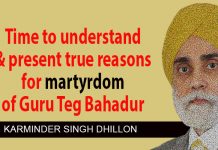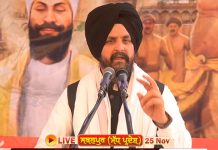
By Gurmukh Singh | Opinion |
No independent theo-political community can survive without good scholars. They are expected to clarify the founding principles and institutions which support its organisational structure and, which prepare it for current and future challenges to its existence. For the Sikhs the collective of the Khalsa Panth is the organisation built on the deep foundation laid by Guru Nanak Sahib.
Over the centuries, during and following the Guru period, starting with Bhai Gurdas, a long line of Sikh scholars contributed to the interpretation and understanding of Gurbani, the lives of the Gurus and Khalsa tradition. They understood that the power was in the Panth (Sangat or collective) and not in any individual. Even the most powerful Sikh in history, Maharaja Ranjit Singh, accepted this Sikhi reality.
In recent years, Sikh Studies in the West have raised the global Sikh profile, albeit, with some negative trends. Contesting Interpretations of the Sikh Tradition, also the title of a book by late Dr Jagtar Singh Grewal, have caused much division amongst scholars and confused modern students of Sikh history, ideology, institutions and identity. One practical consequence of such scholarly divisions for UK Sikhs was the failure to get a dedicated SIKH tick box under the current ethnic count and monitoring system in the 2021 Census. The self-inflicted damage done to community interests will be lasting.
Meditative research-focus (khoj) of Gurbani is essential. A deep study of the continuity of Guru Nanak Jote-Jugat (Divine Light and way of life) from 1469 to this day and the future should guide Sikh Studies. That requires a paradigm shift in approach. Otherwise, we have misleading suggestions like Transformation of Sikh Tradition, also the title of the book by Gokal Chand Narang.
The founding principles of evergreen Sikhi did not change over time, but Sikhi and Sikh institutions responded to the needs of a growing movement to meet environmental challenges. The tree of Sikhi grew and flourished. Scholars of Gursikhi level of Bhai Gurdas understood that Sikhi did not transform or change with the arrival of Guru Hargobind Ji but responded to the external challenges of the times. Miri-Piri, theo-political twin track approach to Sikhi living, was inherent in Bani and the life of Guru Nanak Sahib. Thus, Guru Nanaks One to Ten, continued as One Guru (Teaching Light) to finally reside in Sri Guru Granth Sahib to continue to guide the Khalsa Panth and the whole humanity.
Modern Sikh scholars continue to make the same mistake as early Western scholars who looked at Sikhi through own Western methodology as applied to Eastern religions including Sikhi. They ignored the spiritual aspect to formulate own rational interpretation. Yet, quite hypocritically, they did not apply the same methodology to Christianity! As mentioned by Dr J S Grewal, J.D. Cunningham was rather exceptional in postulating co-relations between ideology, Sikh polity, Sikh social order and Sikh identity.
Early Western scholars lacked knowledge of the living, unbroken and reliable Sikh tradition, which only spiritually dedicated Gursikh scholars could understand and experience in own lives. Exceptionally, Western scholars like Cunningham and M.A. Macauliffe became familiar with the mainsprings of Sikh inspiration. They appreciated the role of Sikh ideology in shaping Sikh history.
Today, modern Sikh scholars in the West need to be aware of own lived-Sikhi limitations before they start offering views about current Sikh issues. They must learn to study Sikhi as an independent system and not one which needs validation against Western or Eastern philosophies.

Gurmukh Singh OBE, a retired UK senior civil servant, chairs the Advisory Board of The Sikh Missionary Society UK. Email: sewauk2005@yahoo.co.uk. Click here for more details on the author. The article first appeared at Panjab Times, UK
* This is the opinion of the writer, organisation or publication and does not necessarily represent the views of Asia Samachar.
RELATED STORY:
1984: When Darbar Sahib became enemy territory (Asia Samachar, 5 June 2025)
ASIA SAMACHAR is an online newspaper for Sikhs / Punjabis in Southeast Asia and beyond. You can leave your comments at our website, Facebook, Twitter, and Instagram. We will delete comments we deem offensive or potentially libelous. You can reach us via WhatsApp +6017-335-1399 or email: asia.samachar@gmail.com. For obituary announcements, click here






























Sikhi cannot be understood merely through outward practices or rituals. Its true essence lies in deep, internal spirituality—reaching the core of what Guru Granth Sahib (SGGS) guides us towards for personal growth. *Sangat* (holy congregation) is just the beginning, a gateway. It’s actually very simple—not some complex or unreachable idea. Like solving a physics or math problem: once we grasp the method, the solution becomes clear.
Remaining at the surface—without turning inward—keeps us trapped in shallow understanding, which risks distorting the true message. As SGGS 121.6 reminds us: *”Bohat Taal Pure, Waje Wajae… Na Ko Sunne Na Maan Lagaaye”*—meaning many rhythms play, but no one truly listens or connects.
This issue is not limited to Sikhi; it’s found in every faith and belief system when people cling to the surface and ignore the depth.
Comments are closed.